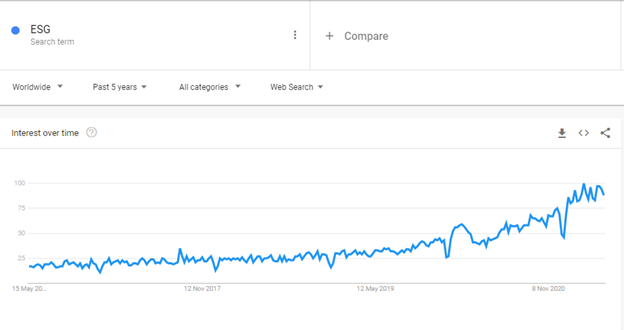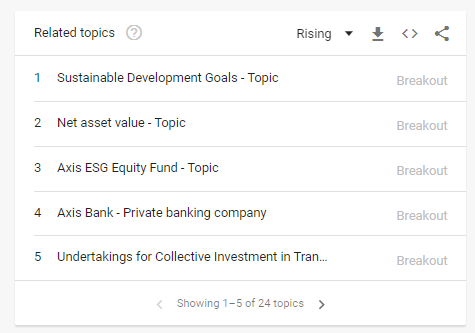When browsing social networks or inspecting cultural, economic or socio-political media, you will have noticed the growing reference to environmental, social and governance factors (ESG) in the corporate and public and private investment worlds. This trend can be observed, for example, by consulting the popularity of the term “ESG” in global Google searches during the last 5 years.

In fact, these factors are no longer presented exclusively as ethical issues or merely a matter of socioenvironmental responsibility. For some years now, investment funds, development banks, corporations, multilateral institutions, among others, have implemented these issues from a more strategic perspective—for example, considering the impacts and benefits that ESG criteria may have on their operations in reputational, economic and operational terms—or simply to meet the growing social expectation that exists on these issues.
And it is emblematic to see how, according to Google searches in the US, the term “ESG” already has more to do with financial terms (equity fund, net asset value, private banking company) than with environmental terms.

Even more representative is the data from the Forum for Sustainable and Responsible Investment (US SIF), the United States-based agency that promotes sustainable investments in capital markets, which, at the end of 2020, announced a 42% increase since 2018 in ESG asset investments in the US market, reaching US$17 trillion.
For institutions that handle an extensive portfolio of operations, such as the IDB, managing these issues is not trivial. To ensure that environmental and social aspects are timely addressed and considered, certain technical assessments and monitoring of operations are required throughout the investment cycle. This can result in significant additional operating costs for the institution.
Therefore, institutions must prioritize the allocation of their resources to monitor ESG criteria in a methodical way, ensuring that the level of care dedicated to each operation is appropriate to the risk, following the proportionality principle.
Proportionality principle for monitoring ESG criteria at the IDB
At the IDB, ESG criteria are managed according to the Environmental and Social Policy Framework, on the basis of which the ESG criteria of all activities financed by the institution are systematically evaluated. From the pre-investment phase, the project teams, in coordination with the Bank’s ESG Unit, evaluate and assign a risk and socio-environmental impact category to the operation. These categories determine the resources and the ESG criteria monitoring regime that the Bank will dedicate to the operations throughout their life cycle.
For the operations with the most relevant impact and risk (approximately 250 operations, a third of the total portfolio), the Bank assigns specialists dedicated to monitoring and evaluating the necessary ESG criteria throughout their life cycle.
For operations with a more limited impact and risk (approximately 420 operations, two-thirds of the operations), the participation of the ESG Unit is focused on the pre-investment phase, whereas during the execution phase, the operational teams are responsible for monitoring ESG criteria. For these projects, the IDB’s ESG Unit has a safeguards guidance service (known as the “ESG Guidance Service”) which can provide advice to project teams when necessary.
Dynamic risk management
The ESG criteria monitoring system at the IDB, and increasingly at other institutions, responds to the aforementioned principle of proportionality. However, we cannot ignore that, throughout the life cycle of an operation, certain context-related factors (such as the socioeconomic or political environment) can cause the exacerbation or lessening of risk factors, meaning resources initially assigned to manage them may no longer be the most appropriate.
Therefore, the IDB has established and implemented a dynamic methodology aimed at optimizing and periodically reviewing the allocation of ESG resources in the monitoring and evaluation of operations. A key pillar of this is the systematized management of the portfolio supervision process, which is based on a combination of quantitative and qualitative techniques.
Regarding quantitative techniques, data analysis constitutes a key tool to strengthen the collection of performance indicators on the operation, the effectiveness of action plans, and the way in which risks are monitored and measured at the portfolio level. It is also a way to transform performance information into global portfolio indicators, identify patterns and trends, and obtain lessons learned, thus helping decision-making for future operations.
In relation to qualitative techniques, the IDB uses methodologies that are based on information gathered from multiple parties involved in the operation through interviews with key informants and focus group discussions, such as with executing agencies and ministries responsible for implementing the operations.
Management optimization using the latest technology
Continuous improvement and the use of innovative tools, such as artificial intelligence and machine-learning systems that enable the detection and analysis of unstructured data and automatization of processes that look for predictive patterns in the ESG criteria of the portfolio of operations, will be key to optimize ESG portfolio management systems.
Such systems will further facilitate monitoring the results of all operations, enabling a more precise and informed global monitoring of ESG criteria at the portfolio level, as well as the identification of trends and early warnings in risk indicators and deviations from agreed ESG measures. This will allow us to improve the overall socioenvironmental landscape of operations as a whole, with a long-term focus and a decision-making process based on a comprehensive socioenvironmental assessment. Additionally, it will let us adapt to unforeseen circumstances, allowing us to solve compliance or socio-environmental performance issues immediately, while avoiding a reputational risk for the institution.


Great blog Alessandro and Alvaro. IDB is a true leader in risk-based portfolio management.